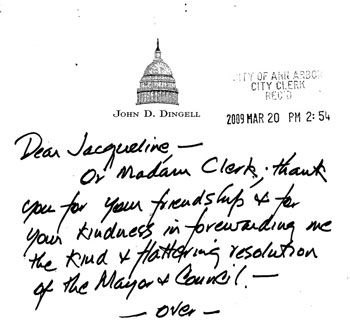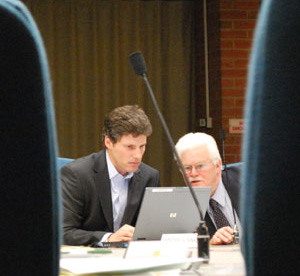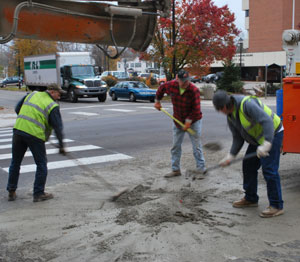Better than it used to be after a big rain. But it is still deeply wet in one of Ann Arbor’s famous low spots near the Allen Creek. [photo 1] [photo 2]
Stories indexed with the term ‘storm water’
Utility Rate Increases Get Initial OK
At its June 6, 2011 meeting, the Ann Arbor city council gave initial approval to changes in rates for drinking water, sanitary sewer and storm water. In terms of revenue generated to the city, the rate increases are expected to generate 3.36% more for drinking water ($664,993), 4% more for the sanitary sewer ($829,481), and 3.35% more for stormwater ($176,915).
Because the rates are part of a city ordinance, the changes must receive a second approval from the city council, after a public hearing.
According to the city, the rate increases are needed to maintain debt service coverage and to maintain funding for required capital improvements.
The city’s drinking water charges are based on a “unit” of 100 cubic feet – 748 gallons. Charges for residential customers are divided into tiers, based on usage. For example, the first seven units of water for residential customers are charged $1.23 per unit. The new residential rate for the first seven units would be $1.27.
The city’s stormwater rates are based on the amount of impervious area on a parcel and are billed quarterly. For example, the lowest tier – for impervious area less than 2,187 square feet – is currently charged $12.84 per quarter. Under the new rate structure, that would increase to $13.24. [.pdf of complete utility rate changes as proposed]
This brief was filed from the city council’s chambers on the second floor of city hall, located at 301 E. Huron. A more detailed report will follow: [link] [Full Story]
More to Meeting than Downtown Planning
Ann Arbor City Council Meeting (Nov. 16, 2009) Part II: The length of Monday’s city council meeting, which did not adjourn until nearly 1 a.m., might be blamed on the lengthy public commentary and deliberations on downtown zoning and design guidelines.

Left to right: Stephen Kunselman (Ward 3), Sabra Briere (Ward 1) and Stephen Rapundalo (Ward 2) getting ceremonially sworn in at the start of council's Nov. 16, 2009 meeting. Standing to the left out of frame are Marcia Higgins (Ward 4) and Mike Anglin (Ward 5). (Photo by the writer.)
But it would have been a long meeting even without the downtown planning content, which we’ve summarized in a separate report: “Downtown Planning Process Forges Ahead.”
Before postponing the acceptance of the Huron River and Impoundment Management Plan (HRIMP), the council got a detailed update on how things stand on the city’s dispute with the Michigan Department of Environmental Quality (MDEQ) over Argo Dam.
An agenda item authorizing capital improvements in West Park prompted a lengthy discussion of how the Percent for Art program works.
Some public commentary calling abstractly for greater support for inventors and entrepreneurs was followed later in the meeting by an appropriation from the city’s LDFA to Ann Arbor SPARK to fund more business acceleration services.
A consent agenda item on the purchase of parking meters was pulled out and postponed.
The council also heard a detailed report from the city administrator, which covered emergency response time to a recent house fire, ADA-compliant sidewalk ramps, responses to the library lot Request for Proposals, updates on the task forces for Mack Pool and Ann Arbor’s senior center, staff reductions in planning and development, the East Stadium bridges, as well as the upcoming budget retreat on Dec. 5.
Stephen Kunselman’s (Ward 3) use of attachments to the agenda to document questions for city staff received some critique.
Also worth noting, the five winners of recent council elections were sworn in, and Marcia Higgins (Ward 4) was elected as mayor pro tem. Those topics in more detail below. [Full Story]
Drain Disconnect Time for Homeowners
No one attending last month’s public meeting at Lawton Elementary looked happy to be there. Nor were they happy about the prospect of holes being dug in their basement and front yard. “My wife and I have lived in our house 30 years and never had a drop of water in the basement,” one man said. “Do I really need this?”

Someone from Mrs. Szalay's kindergarten class at Lawton Elementary made this drawing, which hung in the school's hallway last month on the night of a public meeting at Lawton's gym. The picture's facial expression reflected the sentiment of some homeowners who attended.
“This” is a citywide program to disconnect the footing drains in all houses from the sanitary sewer system. And the answer to his question is “yes” – because the city mandates it.
Much like the sidewalk replacement program, the effort to disconnect footing drains will span several years. But unlike the sidewalk replacement, which homeowners must pay for, the city is reimbursing costs of the drain disconnect – at least for now.
The program started in 2001 as a way to deal with chronic sewer backups in basements of some residential neighborhoods, caused during storms when stormwater would flood that sewer system. In older homes, footing drains – which are designed to divert ground water away from a house’s foundation – were often connected to the sanitary sewer system. With heavy rains, the system didn’t have the capacity to handle the additional rainwater. Sewage would back up into basements through floor drains. It wasn’t pretty [Full Story]
More Zoning? Nope. Street Repaving!!

Thank-you note from Congressman John Dingell as stamped and scanned by the city clerk's office. (Image links to file with both front and back of the note.)
Ann Arbor City Council Meeting Part II (April 6, 2009): We’ve already summarized council’s deliberations on the A2D2 rezoning effort in a previous report.
Here we focus on other business handled by council and topics raised during public commentary at that same meeting. Much of it was related to streets – whether it was vacating them, closing them for special events, or repaving them. The other major theme, as reflected in comments from the public, was public art.
We also include some evidence that the art of the handwritten thank-you note is not dead. [Full Story]
Where Are Ann Arbor’s Trees?

That stick is no ordinary ruler. It's called a Biltmore stick, and has a scale that allows the user to sight the outside limits of a tree's diameter from a single point of view.
On Thursday near 7th and Madison streets, The Chronicle noticed a guy wearing a bright yellow vest with electronic gear and some sort of measuring stick. We had a pretty good idea what it was about, having recently reported on city council’s approval of a $243,500 contract with Davey Resource Group for a GIS-based inventory of trees in the public right-of-way as well as in parks.
Marcia Higgins, one of two councilmembers for Ward 4, had cast the lone vote against the contract, and had explained at Sunday night caucus two weeks later that she would prefer to see the money for the project, which is coming out of the storm water fund, spent directly on storm water. She also wondered if the work could be completed more cost-effectively as a Boy Scout service project.
It’s not Boy Scouts who are doing the work, but rather four guys from Davey Resource Group. One of them is Wes, the guy in the yellow vest, who chatted with us as he took down a couple of trees’ vital statistics: height, trunk diameter, type (genus and species), condition, and location. [Full Story]
Meeting Watch: City Council (17 November 2008)

Carsten Hohnke and Mike Anglin, both of Ward 5, framed by the chairs of Christopher Taylor and Leigh Greden, both of Ward 3.
Outside the Larcom Building around 6 p.m., Ann Arbor Police Lt. Michael Logghe was using a “slim Jim” to try to gain entry to a citizen’s car. The woman had locked herself out of her vehicle with the engine running.
She was there to pay a $15 parking ticket. She was hoping to avoid a call to the tow truck. Logghe had not achieved success by the time The Chronicle headed inside for the reception for new members of council.
Later, inside Larcom, the newly constituted city council with four new members began its year of work by approving the transfer of a liquor license to Quickie Burger, three drainage projects to be implemented to reduce phosphorus load along Allen Creek, plus a contract with Dawn Farms to provide in-patient and out-patient drug abuse counseling and rehabilitation services to the 15th Judicial District Court. [Full Story]
When Concrete and Water Don’t Mix

"Butter," in a red shirt, is the driver of the cement mixer truck that spilled a bit of its load. He's assisted in his cleanup effort by two workers who were radioed to come lend a hand.
When Amy Whitesall filed a Stopped. Watched. item about a concrete spill downtown, The Chronicle wondered if it would still be there by the time we hoofed it over to Huron and Fifth where the spill had occurred.
Yep, still there, but three guys from Superior Materials were attacking the pile of wet cement in the pedestrian walkway with shovels and a broom. (Superior Materials of Farmington Hills bought out Killins Concrete on the west side of Ann Arbor at Liberty and Wagoner about a year ago, but the three-man crew work out of the old Killins location). [Full Story]
West Park Improvements Discussed
By the time the presentation was in full swing, close to 40 people had streamed into a ground-floor meeting room at Miller Manor to hear city of Ann Arbor park planner Amy Kuras, plus a supporting cast of consultants, sketch out options for improvements at West Park and listen to reaction from residents. Residents and planners alike might have disagreed on the specifics, but there seemed to be a consensus on at least one point: the future of West Park should be filled with activity. [Full Story]



